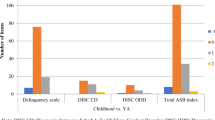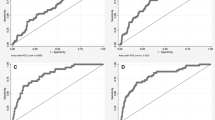Abstract
This study examined the construct validity of antisocial personality disorder (ASPD) diagnosed in adolescence. Boys and girls were grouped by history of DSM-III-R conduct disorder (CD) and ASPD: Controls (n=340) had neither diagnosis; CD Only (n=77) had CD by age 17 but no ASPD through age 20; Adolescent ASPD (n = 64) had ASPD by age 17. The Adolescent ASPD group was then compared to 20 young adult men who met criteria for ASPD (ASPD group). As expected, the Adolescent ASPD group had significantly more depression and substance use disorders, a greater performance>verbal IQ discrepancy, more deviant peers, and poorer academic functioning than the CD Only group and Controls. The Adolescent ASPD and ASPD groups did not differ on most variables. Results support the construct validity of Adolescent ASPD and suggest that such a diagnosis could help identify adolescents at risk for persistent antisocial behavior.


Similar content being viewed by others
References
Barry CT, Frick PJ, DeShazo TM, McCoy MG, Ellis M, Loney BR (2000) The importance of callous-unemotional traits for extrnding the concept of psychopathy to children. J Abnorm Psychol 109:335–340
Bird HR, Gould MS, Staghezza B (1992) Aggregating data from multiple informants in child psychiatry epidemiological research. J Am Acad Child Adolesc Psychiatry 31:78–85
Blair RJR (1999) Responsiveness to distress cues in the child with psychopathic tendencies. Pers Individ Differences 27:135–145
Christian RE, Frick PJ, Hill NL, Tyler L, Frazer DR (1997) Psychopathy and conduct problems: II. Implications for subtyping children with conduct problems. J Am Acad Child Adolesc Psychiatry 36:233–241
Conners CK (1969) A teacher rating scale for use in drug studies with children. Am J Psychiatry 126:152–156
Cornell D, Wilson LA (1992) The PIQ>VIQ discrepancy in violent and nonviolent delinquents. J Clin Psychol 48:256–261
Cottler LB, Price RK, Compton WM, Mager DE (1995) Subtypes of adult antisocial Behavior among drug abusers. J Nerv Ment Dis 183:154–161
Disney ER, Elkins IJ, McGue M, Iacono WG (1999) Effects of ADHD, conduct disorder, and gender on substance use and abuse in adolescence. Am J Psychiatry 156:1515–1521
Farrington DP, Hawkins JD (1991) Predicting participation, early onset and later persistence in officially recorded offending. Criminal Behav Ment Health 1:1–33
Frick PJ (2002) Juvenile psychopathy from a developmental perspective: Implications for construct development and use in forensic assessments. LawHum Behav 26:247–253
Frick PJ, Ellis M (1999) Callous-unemotional traits and subtypes of conduct disorder. Clin Child Fam Psychol Rev 2:149–168
Frick PJ, Lilienfeld SO, Ellis M, Loney B, Silverthorn P (1999) The association between anxiety and psychopathy dimensions in children. J Abnorm Child Psychol 27:383–392
Helzer JE, Pryzbeck TR (1988) The co-occurrence of alcoholism with other psychiatric disorders in the general population and its impact on treatment. J Stud Alcohol 49:219–224
Herjanic B, Reich W (1982) Development of a structured psychiatric interview for children: Agreement between child and parent on individual symptoms. J Abnorm Child Psychol 10:307–324
Hesselbrock M (1991) Gender comparison of antisocial personality disorder and depression in alcoholism. J Subst Abuse 3:205–220
Hsu LM, Hayman J, Koch J, Mandell D (2000) Relation of statistically significant, abnormal, and typical WAIS-R VIQ-PIQ discrepancies to full scale IQs. Eur J Psychol Assess 16:107–114
Jessor R, Van Den Bos J, Vanderryn J, Costa FM, Turbin MS (1995) Protective factors in adolescent problem behavior: Moderator effects and developmental change. Dev Psychol 31:923–933
Kendler KS, Prescott CA, Myers J, Neale MC (2003) The structure of genetic and environmental risk factors for common psychiatric and substance use disorders in men and women. Arch Gen Psychiatry 60:929–937
Krueger RF, Hicks BM, Patrick CJ, Carlson SR, Iacono WG, McGue M (2002) Etiologic connections among substance dependence, antisocial behavior, and personality: Modeling the externalizing spectrum. J Abnorm Psychol 111:411–424
Lahey BB, Loeber R, Hart EL, Frick PJ, Applegate B, Zhang Q, Green SM, Russo MF (1995) Four-year longitudinal study of conduct disorder in boys: Patterns and predictors of persistence. J Abnorm Psychol 104:83–93
Lynam DR (2002) Fledgling psychopathy: A view from personality theory. Law Hum Behav 26:255–259
Moffitt TE (1993) Adolescence-limited and life-course-persistent antisocial behavior: A developmental taxonomy. Psychol Bull 100:674–701
Moffitt TE, Caspi A (2001) Childhood predictors differentiate life-course persistent and adolescence-limited antisocial pathways in males and females. Dev Psychopathol 13:355–376
Moffitt TE, Caspi A, Rutter M, Silva PA (2001) Sex differences in antisocial behavior (pp. 135–150). Cambridge University Press, Cambridge, UK
O’Brien BS, & Frick PJ (1996) Reward dominance: Associations with anxiety, conduct problems, and psychopathy in children. J Abnorm Child Psychol 24:223–240
Pajer KA (1998) What happens to “bad” girls? A review of the adult outcomes of antisocial adolescent girls. Am J Psychiatry 155:862–870
Patterson GR (1986) Performance models for antisocial boys. Am Psycholozist 41:432–444
Pelham WE, Milich R, Murphy DA, Murphy HA (1989) Normative data on the IOWA Conners Teacher Rating Scale. J Clin Child Psychol 18:259–262
Reich W, Welner Z (1988) Diagnostic Interview for Children and Adolescents—Revised: DSM-III-R Version (DICA-R). Washington University, St. Louis.
Robins LN (1966) Deviant Children Grown Up. Williams & Wilkins: Baltimore, MD
Robins LN, Wing J, Wittchen HU, Helzer JE, Babor TF, Burke J, Farmer A, Jablenski A, Pickens R, Regier DA, Sartorius N, Towle LH (1988) The Composite International Diagnostic Interview: An epidemiologic instrument suitable for use in conjunction with different diagnostic systems and different cultures. Arch Gen Psychiatry 45:1068–1077
Rutter M (1967) A children’s behaviour questionnaire for completion by teachers: Preliminary findings. J Child Psychol Psychiatry 8:1–11
Schuckit MA (1986) Genetic and clinical implications of alcoholism and affective disorder. Am J Psychiatry 143(2):140–147
Seagrave D, Grisso T (2002) Adolescent development and the measurement of juvenile psychopathy. Law Hum Behav 26:219–239
Simonoff E, Elander J, Holmshaw J, Pickles A, Murray R, Rutter M (2004) Predictors of antisocial personality: Continuities from childhood to adult life. Br J Psychiatry 184:118–127
Simons RL, Wu C-I, Conger RD, Lorenz FO (1994) Two routes to delinquency: Differences between early and late starters in the impact of parenting and deviant peers. Criminology 32:247–275
Snow M, Thurber S (1997) Cognitive imbalance and antisocial personality characteristics. J Clin Psychol 53:351–354
Spitzer RL, Williams JB, Gibbon M (1987) Structured clinical interview for DSM-III-R. Biometrics Research Department, New York State Psychiatric Institute, New York
Spitzer RL, Williams JB, Gibbon M, First MB (1987) Structured clinical interview for DSM-III-R personality disorders (SCID-II). Biometrics Research Department, New York State Psychiatric Institute, New York
Taylor J, Carey G (1998) Antisocial behavior, substance abuse, and somatization in families of adolescent drug abusers and adolescent controls. Am J Drug Alcohol Abuse 24:635–646
Wechsler D (1981) Manual for the Wechsler Adult Intelligence Scale – Revised (WAIS-R). The Psychological Corporation, San Antonio, TX
White JL, Moffitt TE, Caspi A, Jeglum-Bartusch D, Needles DJ, Stouthamer-Loeber M (1994) Measuring impulsivity and examining its relationship to delinquency. J Abnorm Psychol 103:192–205
Acknowledgements
The present study was supported in part by National Institute of Drug Abuse grant DA 05147 and National Institute on Alcohol Abuse and Alcoholism grant AA09367.
Author information
Authors and Affiliations
Corresponding author
Additional information
Jeanette Taylor is an Assistant Professor at Florida State University. She received her Ph.D. in 1999 from the University of Minnesota. Her research examines biological, cognitive, and environmental influences on personality disorders and substance use disorders.
Irene J. Elkins is a Co-investigator at the Minnesota Center for Twin and Family Research. She received her Ph.D. in 1993 from the University of Kansas and is a member of the Society for Research on Psychopathology. Her major research interests include the relationship of personality, ADHD, and antisocial behavior to substance abuse, as well as gene-environment interrelationships.
Lisa Legrand is a Research Associate with the Minnesota Center for Twin and Family Research at the University of Minnesota. She received her Ph.D. in 2003 from the University of Minnesota. Her major research interests include gene-environment interplay in the development of externalizing psychopathology.
Dawn Peuschold is a Senior Clinical Forensic Psychologist at the Hennepin Country District Court and an instructor at the University of Minnesota. She completed a post-doctoral fellowship in forensic psychology at the University of Massachusetts Medical School after receiving her Ph.D. in clinical psychology from the University of Minnesota. She is interested in risk factors for reoffense in juveniles.
William G. Iacono is a Distinguished McKnight University Professor at the University of Minnesota, the institution from which he received his Ph.D. in psychology. He conducts longitudinal studies of adolescent twins and adoptees aimed at understanding the development of adult adjustment and mental health.
Rights and permissions
About this article
Cite this article
Taylor, J., Elkins, I.J., Legrand, L. et al. Construct Validity of Adolescent Antisocial Personality Disorder. J Youth Adolescence 36, 1048–1057 (2007). https://doi.org/10.1007/s10964-006-9163-1
Received:
Accepted:
Published:
Issue Date:
DOI: https://doi.org/10.1007/s10964-006-9163-1




